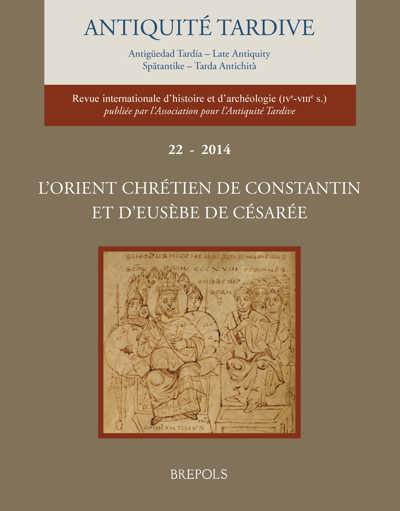Antiquité Tardive 22 (2014)

Dossier – L’Orient chrétien de Constantin et d’Eusèbe de Césarée
R. Lizzi Testa, I centenarii costantiniani e il peso della contemporaneità [Constantinian’s centenaries and the influence of the contemporary] (13)
1 – L’Empereur Constantin et l’église : contexte historico-religieux –
J. Vilella, Constantino y Osio: la última etapa del conflicto arriano preniceno [Constantine and Ossius: the last phase of the pre-Nicene Arian conflict] (27)
A. Martin, La réception du concile de Nicée et son impact sur l’évolution des courants théologiques en Orient (325-381) [The receipt of the Council of Nicaea and its impact on the evolution of theological trends in eastern Churches (325-381)] (35)
H. A. Drake, Nicaea to Tyre (325-335): the bumpy road to a Christian Empire [De Nicée à Tyr (325-335) : le chemin chaotique vers un Empire chrétien] (43)
2 – Aspects de l’Histoire ecclésiastique d’Eusèbe de Césarée –
S. Morlet, Introduction (53); M.-Fr. Baslez, Réflexions sur la notion d’Histoire ecclésiastique à partir des dossiers de correspondances épiscopales [Some thoughts on Eusebius’ concept of Ecclesiastical History based on a study of the episcopal letters] (55)
E. Norelli, Quelques remarques sur la manière dont Eusèbe construit la littérature chrétienne dans son Histoire Ecclésiastique [Some comments on the way Eusebius constructed the Christian literature in his Ecclesiastical History] (61)
R. Gounelle, L’Histoire ecclésiastique d’Eusèbe ou la présence des œuvres perdues [The Ecclesiastical History of Eusebius or the presence of lost works] (71)
J. Gascou, Pourquoi Eusèbe ne mentionne-t-il pas le martyre de Piérios ? [ Why Eusebius does not mention the martyrdom of Pierus?] (79)
3 – Les textes au regard des données archéologiques –
R. Van Dam, “Constantine’s Beautiful City”: the symbolic value of Constantinople [« La merveilleuse cité de Constantin » : la valeur symbolique de Constantinople] (83)
J.-M. Spieser, En suivant Eusèbe au Saint-Sépulcre [Following Eusebius to the Holy Sepulchre] (95)
W. Weber, Überlegungen zur Rekonstruktion der konstantinischen Geburtskirche in Bethlehem [Reflections on the reconstruction of the Constantine Church of the Nativity in Bethlehem] (105)
S. Garreau Forrest, Ali Khalil Badawi, La cathédrale de Paulin de Tyr décrite par Eusèbe de Césarée : mythe ou réalité ? [The Cathedral of Paulinus of Tyre described by Eusebius of Caesarea: myth or reality?] (111)
C. Saliou, À Antioche sur l’Oronte, l’église de Constantin entre histoire et mémoire [Constantine’s church at Antioch, between history and memory] (125)
J.-P. Caillet, Eusèbe de Césarée face aux images : vers une interprétation plus positive – et moins incertaine – de ses attitudes ? [Eusebius of Caesarea and the images: toward a more positive – and less uncertain – interpretation of his views?] (135)
_____________
Varia
J.-F. Nardelli, St. Ratti, Historia Augusta contra christianos. Recherches sur l’ambiance antichrétienne de l’Histoire Auguste [Historia Augusta contra christianos. An overview of the anti-Christian atmosphere in the Historia Augusta] (143)
D. Piay Augusto, …At tum Instantius, Salvianus et Priscillianus Romam profecti: El viaje de los priscilianistas hacia la Ciudad Eterna […At tum Instantius, Salvianus et Priscillianus Romam profecti: the Priscillianists’ itineraries to the Eternal City] (156)
I. Tantillo, Praesides, comites, duces. La Tripolitania e l’amministrazione dell’Africa tardoromana [Praesides, comites, duces. Tripolitania and the administration of late Roman Africa] (177)
M. Landelle, La titulature des magistri militum au IVe siècle [The title magister militum in the 4th century AD] (195)
St. Del Lungo, Provincia Lucania: topografia e agrimensura in un paesaggio che cambia, dalla Tarda Antichità all’Alto Medioevo (seconda parte) [Provincia Lucania: topography and land survey in a changing landscape, from Late Antiquity to the Early Middle Ages (part 2)] (223)
H. Ménard, Violences polysémiques et construction mémorielle : la Passion de sainte Salsa de Tipasa [Polysemous violence and the construction of memory: the Passion of Salsa of Tipasa] (235)
W. Liebeschuetz, How God made the world in seven days: The commentaries on genesis of John Chrysostom (Homilies 1-12) and of Eusebius of Emesa (1-10) and the school of Antioch [Comment Dieu créa le monde en sept jours : les commentaires de la Genèse de Jean Chrysostome (Homélies 1-12) et d’Eusèbe d’émèse (1-10), deux représentants distincts de l’école d’Antioche] (244)
M. Petitjean, Classicisme, barbarie et guerre romaine : l’image du cavalier dans l’Empire romain tardif [Classicism, barbarism and Roman warfare: the figure of the cavalryman in the Late Roman Empire] (255)
I. Jacobs, Ecclesiastical dominance and urban setting. Colonnaded streets as back-drop for Christian display [Domination ecclésiastique et espaces urbains. La rue à colonnade comme toile de fond de l’affirmation Chrétienne] (263)
Chronique
J. Dresken Weiland, Laien, Kleriker, Märtyrer und die unterirdischen Friedhöfe Roms im 3. Jahrhundert [Laymen, clerks, martyrs and the subterranean cemeteries of Rome in the 3rd century] (287)
J.-M. Spieser, À propos de trois livres récents sur des monuments de Thessalonique [About three recent books on the monuments of Thessaloniki] (297)
Bulletin critique




